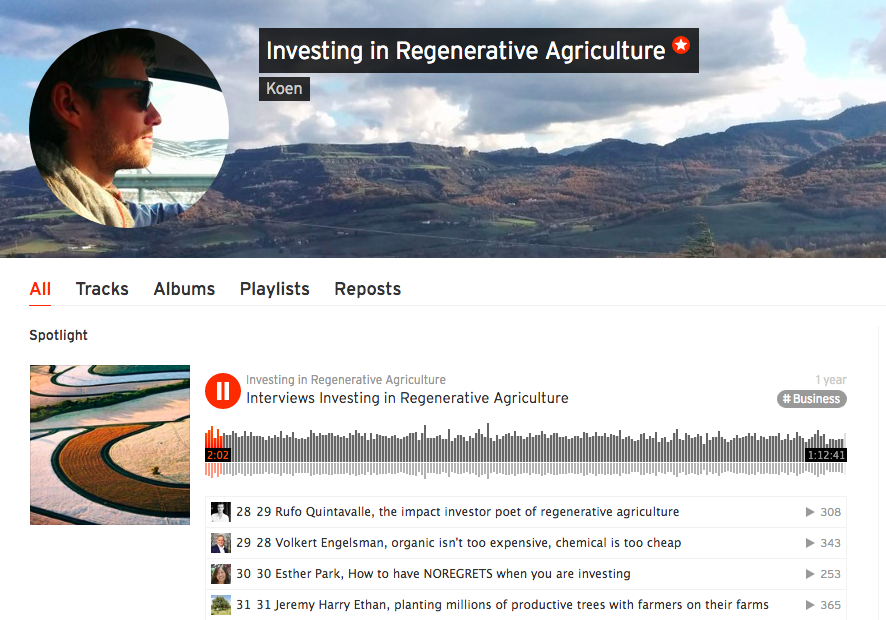Curated top stories in Regenerative Agriculture, Business, and Investing • ethansoloviev.com
20 Million Acres Transitioning to Regenerative Ag, World Bank Promotes Agroforestry, $40 Million Raised…

Regenerative Agriculture
Carbon Farming Works. Can it scale up in time to make a difference? – Link
Towards Regenerative Fashion: Stony Creek Colors grows Indigo for blue dye on former tobacco fields in Tennessee USA, scales up operations, and claims to improve the soil. Read more at https://stonycreekcolors.com/ and even buy their dye on Amazon!
Here’s a short & sweet primer on carbon farming, mislabeled as regenerative agriculture:) Larger and larger venues picking up on the concept, exploring it with great interest and low rigor. – [Link]
Succinct introduction to regenerative agriculture in ‘The Conscious Carnivore Guide’ from the New Food Economy. – Link
There’s slow but steady news of small farms aiming for regenerative agriculture trickling into mainstream press: Like here from western Canada, here from southern Minnesota USA, and here from North Carolina USA.
This industrial greenhouse operation growing growing mostly non-organic with chemicals claims they will go regenerative… I’ll believe it when I see it! – Link and Link
Ben Dobson and the good folks at Hudson Carbon offer a new write-up (kind of like their extended definition) of regenerative agriculture. Includes some interesting ecosystem-derived insights. The group’s practical on-the-ground work and scale are outstanding, though I think their mostly-soil focus misses the deeper layers of Regenerative Agriculture that are possible. – Link
You can now grow monoculture corn, till, spray pesticides, not be organic, not necessarily increase soil carbon, and still be a “Regenerative Farm”. Amazing how fast the watering-down is proceeding. – Link
Aside from the flagrant mis-use and banalization of “regenerative”, the results from this peer-reviewed article are awesome and encouraging! Turns out basic conservation ag practices increase farm profits and have some positive effect on biodiversity. – Link
Some quotes from the article [brackets are my addition]:
- “Pests were 10-fold more abundant in insecticide treated corn fields than on insecticide-free [so-called] regenerative farms,”
- “[So-called] Regenerative fields had 29% lower grain production but 78% higher profits over traditional corn production systems”
- “Profit was positively correlated with the particulate organic matter of the soil, not yield”
- “Simply applying individual regenerative practices within the current production model will not likely produce the documented results.”
Are 20 million acres of land really going to transition to regenerative agriculture? Here’s a UN project scaled with massive government support and an innovative public/private financing system. World Agroforestry Centre involvement; key will be “placing farmers at the forefront of knowledge creation and dissemination.” – Link
Podcasts
(Top podcast this month) Investing in Regenerative Agriculture – My friend Koen van Seijen interviews up-and-coming organic grains powerhouse Pipeline Foods. I recommend listening to his whole series. – Link

Rodale Institute scientists explain their case for regenerative ag. Rodale’s perspective is mostly focused on tried-and-true organic farming practices that produce small increases in soil carbon – there’s a lot more that can be done if trees are added to the mix through agroforestry. – Link
Ecosystem Diversity Prevents Insect Pressure with John Kempf. – Link
A Cattle Farmer & Consultant jam on regenerative ag. – Link
Agroforestry
World Bank leads an effort to promote agroforestry for major commodity crops (Corn, Soy, Palm Oil), also explores crops that should be grown in agroforestry systems (Cocoa, Coffee, Shea). – Link
Propagate Ventures Interviewed on their agroforestry investment model. These guys are fun. – Link
Investing
Food Tank interviews Wood Turner of Ag Capital, who have recently adopted the term “Regenerative Agriculture” without any apparent change in their large-scale monoculture operations. The perennial nature of their crops (Hazels, blueberries, citrus) does indeed make them more likely to have a net-positive impact — but as far as I can tell they haven’t documented it, or done anything deeper than using a new word. Nevertheless, this is a good read. – Link
3 Trillion committed to invest in “companies that factor climate risks into their strategies”. While at first glance this might seem great, it will not lead directly to regenerative agriculture or even much change from business as usual – many global petroleum companies put a lot of focus on upcoming climate risks… – Link
Wide Open Ag raises $5m (AUD) in IPO on ASX exchange. Company claims to be doing “diversified, regenerative agriculture”. They use the “4 Returns” Framework developed by the Commonlands Foundation. – Link
$15m Raise – Midwestern Bio-Ag is a stalwart in good organic agriculture practices, products, and support. They’re partnering with General Mills (including a multi-million dollar investment) on the Gunsmoke Farms project, which while touted as “regenerative.” Looks like it will basically be organic. – Link
Six Lessons from Investor Survey As land-grabbing continues and local communities fight back, it is imperative for investors to consider land rights when making agricultural or natural resource investments. USAID surveys the field and presents 6 key findings. (They’re kind of obvious :/ but it’s a good start.) – Link
Related, and more interesting: Indigenous peoples manage or own more than 25% of earth’s land?!? Thank goodness. – Link
Sail Cargo – Here’s a far-out investment opportunity from the past, for the future. Carbon-negative sail-trade of regenerative agroforestry product. I recommend going through the investor booklet. – Link
Regenerative Business
Leadership is not about motivating or inspiring people. Wait, what? – Link
This business has been rocking it for a while. Great article on Dr. Bronner’s regenerative agriculture work – Link
Herbal infused drink-maker REBBL raises $20 million to continue growing – Link
Competition for regeneration – Still a long ways to go until a functional business sprouts here, but the initial numbers sound good… Link
Ethan Soloviev’s big-picture interpretation of this month’s news:
“Regenerative” Agriculture has within the last 6 months exploded beyond it’s previous audience and advocates, who were primarily in the permaculture and holistic management communities. With its quick expansion has come immediate watering-down, with most people now thinking that regenerative agriculture just a few basic conservation agriculture practices. (I beg to differ – see this white paper for details.) Even non-organic farms practicing tillage, using insecticides, and not certified organic can be “regenerative” – without regard for whether or not they are actually regenerating anything.
Following General Mills’ lead, other Ag & Food business conglomerates will also announce “regenerative” initiatives. I predict that Bayer-Monsanto and others will start promoting “Regenerative” agriculture within 24 months.
What does this mean? The greenwashing will continue to grow in scale and brazenness. The farmers and entrepreneurs working towards deeper levels of regenerative agriculture will continue their work with integrity, but it will be harder for them to stand out and differentiate their offerings. Certifications like the “Regenerative Organic Standard” won’t do much to help, because their checklist-format criteria can’t account for the unique brilliance of individual farms and farmers.
I hope I’m wrong. Stay tuned in the coming months to find out.
– Ethan Soloviev
If you enjoyed this issue of Regeneration Newsroom, please forward this to a friend that would find the information valuable!
Sign Up | Follow on Twitter | Read on Medium
Need to contact me? Have any feedback on coverage? Email me at e@ethansoloviev.com

